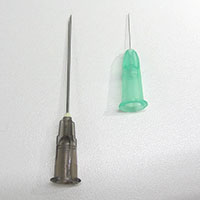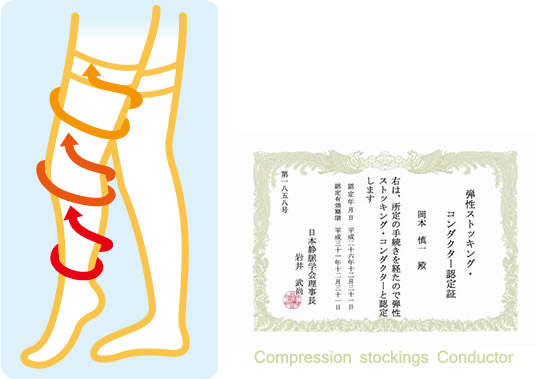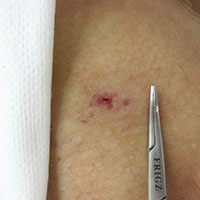ENDOVENOUS TREATMENT (VASCULAR IVR TREATMENT)

Up until the Japanese medical insurance was applicable to intravascular cautery treatments, patients usually applied for a "vein stripping operation" which involved a full removal of varicose vein. This procedure involves an incision at two locations, and may damage the tissue surrounding the varicose vein. This caused large amounts of pain and swelling after the operation, forcing patients to be hospitalised after treatment.
Since 2011 vascular treatment of lower limb varicose veins became applicable for Japanese medical insurance, and caused a dramatic change in this medical field. Endovenous treatment involves inserting a catheter into the affected vein, which induces heat caused by high frequency radio waves (or a laser) to close and seal the blood vessel.
The appeal of this method is that no scars are formed during the operation and there is no damage to any surrounding tissue. Very little pain or swelling occurs during or after the operation. Although laser surgeries are more common and well known, recent studies have illustrated that radiofrequency ablation results in less discomfort for the patients after the treatment.
Endovenous treatment prevents vein reflux (reverse blood flow) in varicose veins, creating a healthier supply of oxygen to cells and tissues in the leg. The exclusion of the varicose veins will not cause any side effects post treatment. Endovenous treatment attenuates all visible symptoms, including the "tumour-like" lumps, fatigue and cramps.

SCLEROTHERAPY

Sclerotherapy is a treatment method to completely remove either the blood vessels visible through the skin, or varicose veins which are not treatable with lasers or high frequency radio waves.
The injected blood vessels degrade overtime, becoming smaller and ultimately becomes absorbed by natural bodily mechanisms. Blood vessels which are destroyed in this process are not crucial to the body and your blood will be redirected to one of your healthy veins.
For those who may feel uncomfortable with a needle injection, this treatment method relies on an extremely thin needle tips which are barely visible by the naked eye, causing minimal pain during the injection. In parallel to this we also use a substance called polydocanol-a natural anaesthetic which further reduces any painful stimulation.
The treatment takes approximately 10 minutes and the procedure can be done on the first visit. Patients may return home within the day of the treatment.

COMPRESSION STOCKINGS FOR LESS SEVERE VARICOSE VEINS

For patients with minor symptoms, or would like to avoid laser treatments for personal reasons, we recommend graduated compression stocking treatment.
Medical compression stockings are made to be much more effective than its counterparts found in drug stores and on the internet. Due to its specific shape, the stocking applies pressure from the lower regions of the leg and prevents the accumulation of blood and reduces swelling. To have maximum treatment effect and prevent any side effects to the skin, the correct size must be chosen for the patient. Compression stockings come in a large variety of length and sizes.
Our head of the clinic, Dr Okamoto, has obtained a licence for the application of medical compression stockings. All our staff have been educated in size selection and fittings of the stockings for our patients for a safe and effective output for the treatment.
STAB AVULSION METHOD

Even after endovenous treatment, large lumps in the leg caused by varicose veins may remain for longer than 6 months post-operation. If our patients want the lumps fully removed, we undergo "stab avulsion". We enter the damaged region with our medical equipment through a 1-3mm incision into the skin and remove any debris forming the lump.
The cuts are very small and don't need to be sutured, with no visible scars left after a year. The combination of Laser or radiofrequency ablation and stab avulsion should completely remove lumps caused by varicose veins.
VEIN STRIPPING OPERATION
The "stripping" method removes the varicose vein entirely to prevent any atypical blood flow in the affected limb. Before endovenous treatment was applicable for medical insurance, this was the most common method of treatment in Japan.
Our clinic specialises in non-invasive high frequency treatment, however we still have this treatment option for patients with severe cases of varicose veins, such as high levels of atypical blood flow or brownish-yellow skin discolouration around the upper thigh.
We also recommend "vein stripping" for patients with abnormal meandering blood vessels which makes radiofrequency ablation very difficult.
ANAESTHESIA

We undergo intravenously administered full anaesthesia of the whole body (Induces sleep) alongside a local anaesthetic of the limb before radiofrequency ablation treatment.
Although just the local anaesthesia of the limb is sufficient to perform the treatment, we initially induce a whole-body anaesthetic to prevent any unnecessary pain induced by the multiple needles used during the local anaesthetic.
Furthermore, we reduce the duration of the effects of the anaesthetics to prevent any doziness after the operation. You won't feel any pain during the operation or after it, causing no problems to the rest of your day.
TREATMENT COSTS
We accept all forms of Japanese medical insurances. Patients from overseas without any medical insurance are also welcome to our hospital for treatment.
| If you Don't have Japanese medical insurances. | |
|---|---|
| Radiofrequency ablation treatment (For one leg) | 143,000JPY Tax included |
| Radiofrequency ablation treatment (For both legs) | 270,000JPY Tax included |
※1.The prices shown above includes all costs (operations and examinations).
※2.Patients without any Japanese medical insurance will need to pay the full treatment cost. Thank you for your understanding.
※3.Any undiscussed or sudden changes to treatment plans may results in extra charge for treatment and operations.



